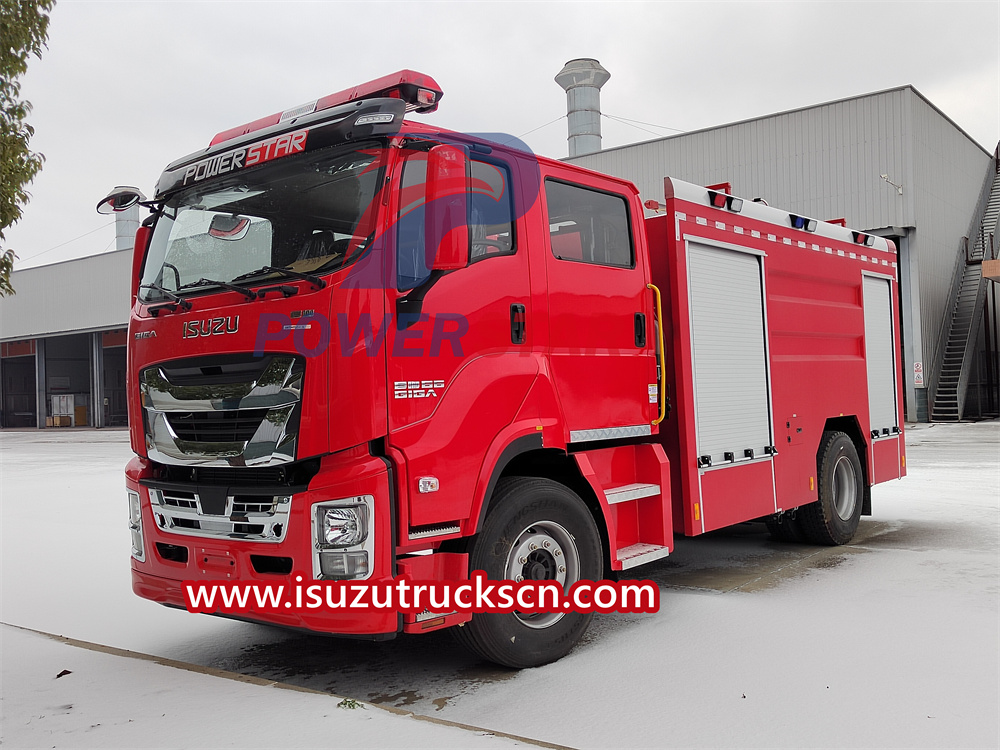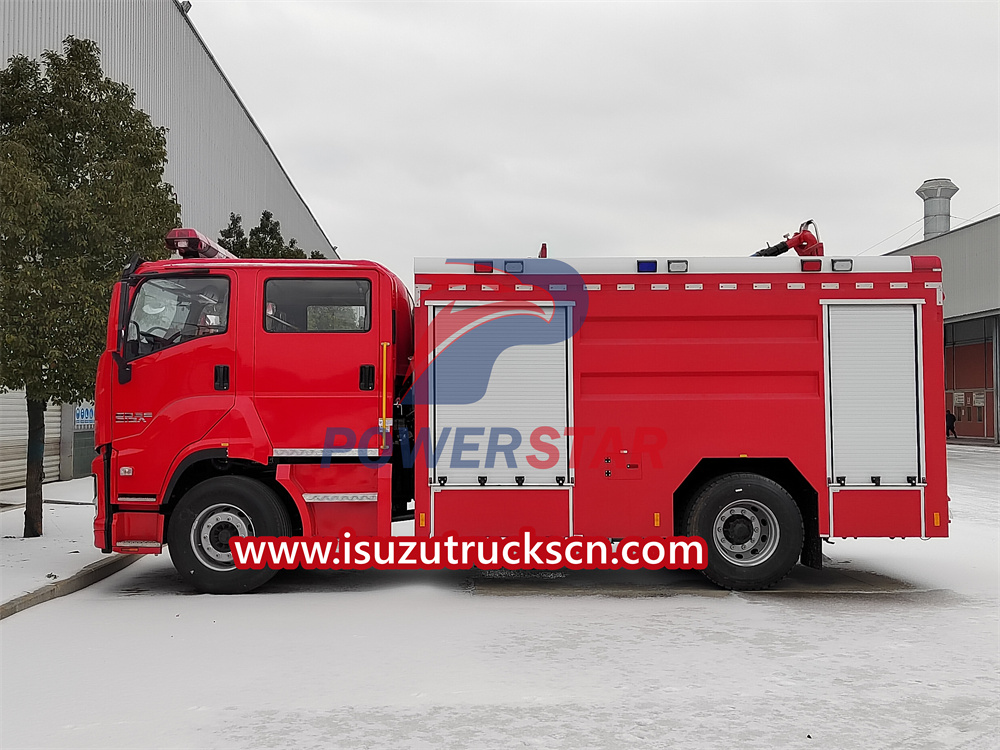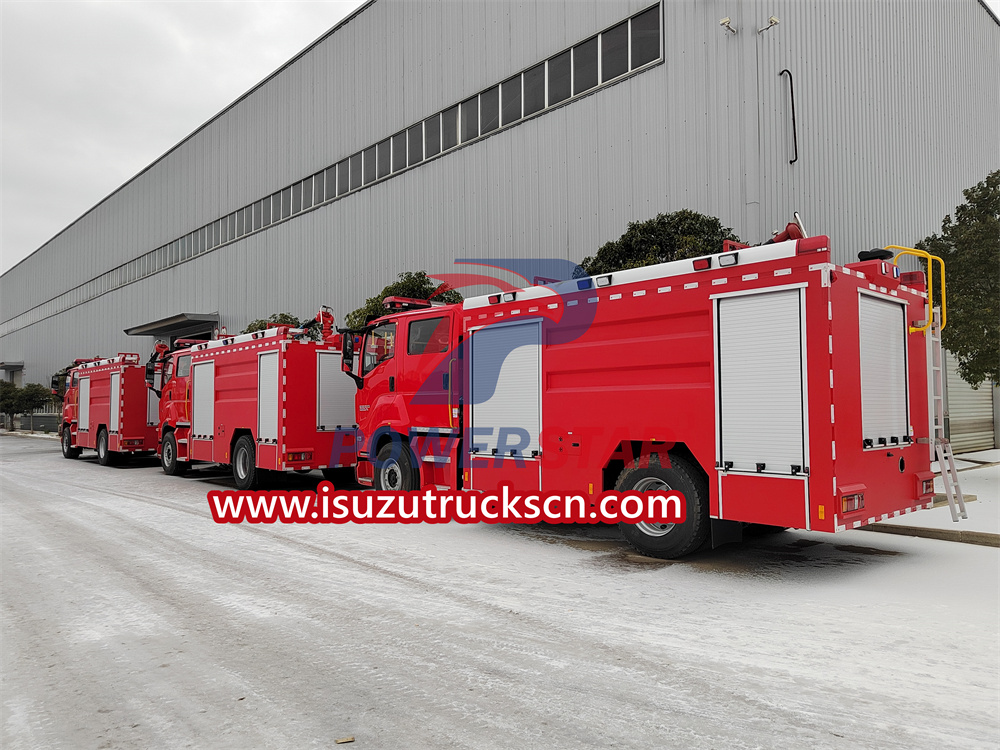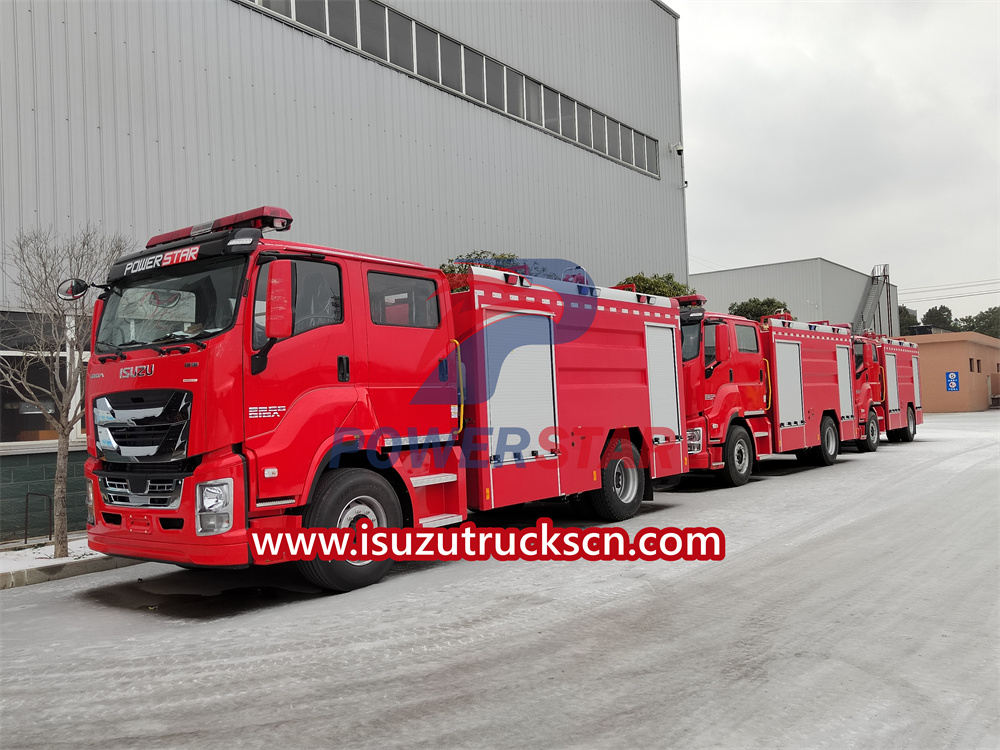


Whether it is fuel or engine oil, they are indispensable for Isuzu fire trucks. There are many techniques and methods for refueling and using oil. Regardless of the price of the Isuzu fire truck, the correct use of automotive oil will not only reduce damage to the Isuzu fire truck, but also make the Isuzu fire engine durable.
If you want an Isuzu fire truck to be durable, you must also pay attention to the use of oil. How do fire trucks use oil correctly? You also need to pay attention to the following tips for using oil.
Too long in-situ preheating time increases fuel consumption
Some drivers always start their vehicles every morning so that the fire trucks have sufficient time to warm up before going on the road. This approach is actually a misunderstanding of vehicle preheating, which will also increase fuel consumption. Because the car is parked for too long, the oil in the engine will flow back to the oil pan, and the oil film on the contact surfaces of the machine parts will become thinner. Therefore, the purpose of preheating is to allow the oil to be pumped to various moving parts, thereby reducing engine wear. The correct method is to preheat the engine to the appropriate temperature before igniting it. In addition, because the engine consumes a lot of fuel when it is cold, the warm-up time should not be too short when starting the cold car. If there is no time to warm up, you can also let the car drive slowly for one or two kilometers to achieve the warm-up effect.
Using oil with excessive viscosity will consume more fuel
Some car owners want to take good care of their Isuzu fire trucks and only use oil with excessive viscosity. Unexpectedly, it increases the burden on the vehicle. The viscosity of the lubricating oil is undoubtedly crucial to the normal operation of the engine. In order to prevent the contact surfaces between the moving parts of the engine from wearing, the lubricating oil must have sufficient viscosity to form an oil film between the moving parts at various operating temperatures, thus Keep your car engine running smoothly. However, using lubricating oil with excessive viscosity will have at least two disadvantages. First of all, when the viscosity is too high and affects the degree of engine starting, it is likely to cause serious wear when the engine is started. Because the viscosity of the lubricating oil is too high and the flow is slow, although the oil pressure is high, the amount of lubricating oil passing through is not large and cannot be replenished to the friction surface in time. The circulation speed of the oil also slows down, and its cooling and heat dissipation effects will become poor, causing the engine to overheat. Due to the slow circulation speed of the lubricating oil, the number of times it passes through the lubricating oil filter becomes less, so it is difficult to clean the worn metal chips, carbon particles, and dust from the friction surface in a timely manner. In addition, due to excessive viscosity, the friction between the friction surfaces of the machine parts increases. In order to overcome the increased friction, more fuel must be consumed, resulting in a huge waste of energy.
Fuel consumption suddenly increases, fire trucks may become "sick"
If the fire truck's fuel consumption suddenly rises significantly, it is likely that it has some problems at this time. The most common causes are as follows.
For example, the distance is significantly reduced when coasting in neutral, which is related to the air pressure of the tires. If the tires are under-inflated, it will directly lead to an increase in fuel consumption. At the same time, if the tires are severely worn, they will also slip and increase fuel consumption. If you hear abnormal noises from the tires while driving or starting, you need to promptly check whether the bearings and braking system are faulty. Improper wheel rotation will also affect vehicle speed and increase fuel consumption.

Isuzu fire truck in our plant
Refueling when the oil light is on shortens the life of the oil pump
Some car owners feel that they can still drive a certain mileage below the fuel gauge warning line. I developed the habit of refueling when the oil light comes on. In fact, the oil pump is located in the fuel tank, and the temperature is relatively high during continuous operation. The oil pump can be effectively cooled by being immersed in fuel. When the oil light comes on, the oil level is already lower than the oil pump. If you wait for the light to come on every time before refueling, the service life of the oil pump will be shortened. If there is too little oil or the fuel is exhausted, the oil pump may be burned. Vehicles that have traveled more than 30,000 kilometers should be even more careful. When there is too little oil, once the oil pump pulls up the sediment at the bottom of the fuel tank, it will block the oil pump or block the oil circuit.
You can also refuel at night in places with large temperature differences.
Experienced drivers know that after the oil at the gas station settles overnight, its impurities and sludge will sink to the bottom of the oil tank, and the oil added to the car will be relatively clean. In fact, choosing refueling time in the early morning is certainly the right thing to do. But if you are in a place where the temperature difference between morning and evening is large, you can also choose night. Because the high thermal expansion coefficient of fuel is sensitive to temperature changes, and under normal circumstances, the temperature difference between morning and evening and daytime is more than 10 degrees Celsius, and the vaporization point of gasoline is relatively low, you can choose another refueling period at night. Of course, Don’t choose to refuel when a gas truck is approaching the gas station.
"Eating" too much damages the car and consumes fuel
When traveling during holidays, most people worry about refueling. Fill up as soon as you get to the gas station. If it’s more convenient to find a gas station, you don’t need to fill it up all at once. Because this will increase the weight of the vehicle and the fuel consumption will also increase. Especially for new cars, it is not advisable to fill up the tank at once. This may cause the oil to float and the sensor to malfunction, resulting in distortion of the fuel gauge.
In addition, refueling should not be overflowed. When the vehicle is running or stalled, the activated carbon in the car's carbon canister can absorb the gasoline vapor in the fuel tank, prevent the gasoline vapor from entering the atmosphere, and allow fresh air from the outside to enter the fuel tank through the carbon canister, so that the fuel tank Maintain good ventilation. When the engine is running, the solenoid valve of the fuel evaporation purification device installed between the carbon canister and the intake manifold opens, and the gasoline vapor in the carbon canister is sucked into the intake manifold for combustion. If the vehicle's fuel tank is overfilled, the gas outlet of the fuel tank may be buried in gasoline, and gasoline liquid instead of gasoline vapor enters the canister, causing harm to the canister.

Isuzu fire truck for export
What are some fuel-saving tips when using fire trucks?
Pay attention to driving skills and master their characteristics
1. When driving an Isuzu fire truck, consider the performance of the vehicle itself. Due to the particularity of Isuzu fire trucks being on duty at all times for rescue, they have been under heavy load for a long time. Therefore, when driving, you must be careful not to drag the vehicle into gear. You should increase or decrease the transmission gear in a timely manner according to the speed of the vehicle to avoid dragging the vehicle. Because driving in gear for a long time will inevitably increase fuel consumption and accelerated wear of mechanical parts.
2. The Isuzu ire trucks often start under heavy load. This requires our drivers to master the operating skills and technical requirements when starting the vehicle. Carefully understand the technique when pressing the clutch pedal (ie: fast at both ends and slow in the middle). The accelerator pedal should be accelerated gradually, that is, gradually press down on the accelerator. Do not use the half-clutch and slam the accelerator. This is true for many drivers. Especially veteran drivers. This may seem like a smooth start, but it wastes a lot of fuel. The key to a smooth start lies in the coordination of the left and right feet. If you work hard on this, you will save a lot of fuel.
3. When you step on the accelerator to accelerate, the force should be even. Do not step on the accelerator deeper and shallower. This will inevitably cause the mixture to be too rich or too thin, so that the fuel mixture cannot be completely burned in the combustion chamber and is forced to be discharged from the body. That is to say, it increases fuel consumption and reduces engine power. The powerful kinetic energy generated by the complete combustion of the mixture should be fully utilized, and the powerful inertia generated by the vehicle should be fully utilized to keep the vehicle running in the best economical state, so as to save fuel.
4. When stepping on the accelerator pedal, be sure to retract and release it freely. According to the engine speed requirements, add as much oil as needed to prevent the engine from idling at high speed without load.
5. In addition, when the vehicle is driven at high speed or low speed for a long time, it will also increase fuel consumption. This requires foreseeing the road conditions, paying attention to changes in traffic lights and handling special situations, and trying to avoid emergency braking. Driving skills are very important. For the same car, mastering good driving skills can save 8% to 15% of fuel.

Isuzu 4x2 fire engine for sale
Pay attention to check the temperature of the engine and grasp its performance
As we all know, the circulating water temperature of general vehicles is between 80 and 90 degrees. If the water temperature is too high, it will affect the heat dissipation of the engine, thereby increasing fuel consumption. Generally, when the water temperature exceeds 95 degrees, the fuel consumption increases by 20% to 20% compared with normal temperature. Thirty percent. Therefore, it is necessary to regularly check whether the engine water circulation system is normal and whether there is any blockage in the water path. Also check whether the electronic fan is operating normally at any time. Whether the liquid level in the water tank reaches the specified height and whether there is water shortage. The outside of the engine should not be too dirty, otherwise poor heat dissipation will also affect the increase in fuel consumption.
The impact of tire pressure on fuel consumption cannot be ignored
The air pressure of your car's tires also has a great impact on fuel consumption. When the tire pressure is insufficient, the contact area between the tread and the ground increases, and the friction with the ground also increases. The engine has to do more work to overcome the friction, which also increases fuel consumption. Therefore, insufficient tire pressure will directly affect fuel consumption. In addition, insufficient tire pressure will accelerate tire wear.
To cultivate good fuel-efficient habits and strengthen diligence and thrift.
Some drivers always keep the car idling when the vehicle is parked, which is a huge waste of fuel. Therefore, you should develop the habit of turning off the engine after parking. Try to avoid unnecessary long-term operation of the vehicle-mounted water pump in a fire scene. The power of the vehicle-mounted water pump comes directly from the power of the engine. Long-term unnecessary operation greatly increases fuel consumption. In addition, vehicles with air conditioning systems should minimize the use of air conditioning.

Isuzu fire truck produced by our factory

Isuzu fire truck used for fire fighting and rescue




